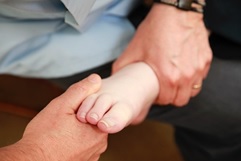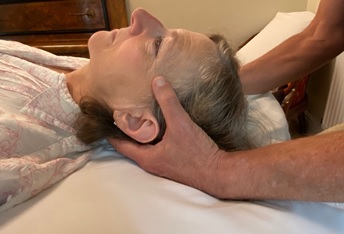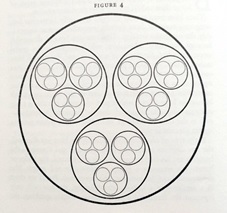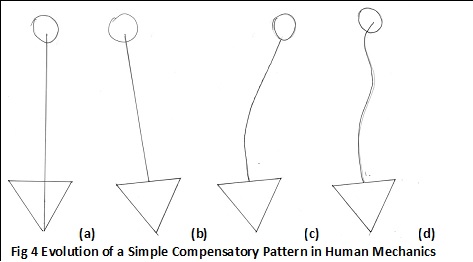Positive Health Online
Your Country

Fulcra in Osteopathy and Craniosacral Therapy
by Jonathan Lawrence(more info)
listed in craniosacral therapy, originally published in issue 282 - November 2022
The term ‘fulcrum’ has a deeper meaning in osteopathy and craniosacral therapy then in general usage. It can be used in a concrete or abstract manner. It can even relate to purpose in life. There are certain psychological states where one loses emotional contact with everything. Where there is no connection there is no sense of purpose.[1]
From the Dictionary: FULCRUM
- The point or support on which a lever pivots.
- Zoology An anatomical structure that acts as a hinge or a point of support.
- An agent through which vital powers are exercised.[2]
Osteopathy is based on the idea that structure governs function. Thus, if the structure of the body is disturbed the function is impaired leading to disease. Another key idea is the body is inherently self-healing. Osteopathy has developed since its inception, taking on new discoveries and developments in the medical sciences as well as many new treatment techniques. Some of the latter are comparatively esoteric such as biodynamic craniosacral therapy. However, despite the variations all these approaches are based on the same fundamental osteopathic principles.
Although osteopathy is holistic in nature it emerged towards the end of the 19th Century and much of the founding ideas and concepts were couched in mechanistic terms, the language of that time. The body was therefore conceived as a machine, though in the founder’s view operated by a vital/spiritual energy.
Andrew Taylor Still, the founder was deeply interested in anatomy, but he was also a religious man with Native American roots. One can speculate that perhaps there was some shamanic influence on the development of this new concept.

Fig. 1 Classical Osteopathic Fulcrum
Concepts of Fulcra in Osteopathy and Craniosacral Therapy
The General Osteopathic Treatment (GOT) is a Classical Osteopathic approach that adjusts the whole body of the patient in a systematic way applying leverage to joint and soft tissue articulations. A skilled exponent of the technique applies this in way that is tailored to the needs of the patient. The operator’s hands are deployed in such a way as to correct, enhance, stimulate, or inhibit the tissues as necessary. These movements are applied in a gentle rhythmical manner to optimise the response of the patient.
As an example, the practitioner would work on the sacro-iliac joint with the patient supine on the plinth. The operator stands to the side of the patient at the level of the pelvis with the patient’s knee and hip flexed circumducting the hip with one hand while the other hand is deployed under the same side of the pelvis fingers applying pressure on the S/I joint. This creates a fulcrum that adjusts the structural relationships through the freeing of any restrictions encountered.

Fig. 2 Craniosacral Fulcrum
In Craniosacral osteopathy, an intrinsic involuntary motion (IVM) is perceived through the body. This motion is an expression of health. Each individual structure expresses the motion according to its design. The movement is biphasic, a flexion/extension and a widening/narrowing around it’s unique fulcrum.
In order to treat the disturbed function, the practitioner will often follow the dysfunctional motion to allow the self-correcting mechanism to do its job. In effect the practitioner creates an external fulcrum around which the system can adjust itself.
To compare this method with the Classical Osteopathic approach for the sacro-iliac joint outlined above, the craniosacral practitioner would contact the sacrum with the hand introducing the external fulcrum. He/she then allows the sacrum to self-modify the IVM via the purposeful contact, thus enabling self-correction.
The establishment of the fulcrum includes the intent of the practitioner. Thus, there is a mental component to the process.

Fig. 3 Nested Hierarchy of Holons [3]
If we think of the body as a whole, comprising a nested hierarchy of components and sub-components (holons) all working in harmony, we can think of a series of fulcra at each hierarchical level.
Any disturbance in one component will affect the rest of the system. The body can compensate for this by creating adaptations in function. For example, if one leg is shorter there will be a series of compensatory adjustments allowing functionality to be maintained. This stress within the system can be readily accommodated. Nevertheless, the threshold for system to fail, whether mechanically or for the insidious development of pathology such as osteoarthritis is lowered.

At the highest hierarchical level, we can think of a whole system fulcrum. In Craniosacral therapy this is known as the Sutherland Fulcrum (SF).[4] This is the Straight sinus, a major cranial venous structure that originates at the confluence of the internal dural duplications (reciprocal tension membranes (RTM)) at the back of the head. Major trauma can displace this fulcrum and it is not uncommon for this to be located off the body.
Lucy (24) came to see me with headaches at the base of the skull on the left. This had come on a few months after suffering a whiplash. She had seen an osteopath and chiropractor giving temporary relief but with symptoms returning as before.
On palpating the IVM it was found that the Sutherland fulcrum was located above and about 40cms to the right of the head. There was a sense of a vector of force that had displaced the SF. By placing one hand at the SF and the other in the occipital area it was possible over a series of treatments to bring the SF back the normal position. During this process the symptoms reduced and eventually went altogether.
Another patient, Clare (55) came with neck pain. She omitted to tell me during the case history that she had had a road traffic accident (RTA) 3 decades earlier. I palpated a compressive fulcrum when working on the upper thorax as one would expect from an RTA where the seatbelt presses into the chest. She recalled the accident and was most impressed that I had picked this up.
A farmer, Joseph (60) came to see me with rib and upper thoracic pain. This had occurred following having his torso crushed when a herd of cows came through a gate he was standing against. He suffered no broken bones but was badly bruised and shocked. This had occurred 6 months prior to his first consultation.
Following this accident taking a deep breath had been painful which resolved in a month. Craniosacral examination found no fulcrum in that area, not even off the body. I asked a colleague for a second opinion, and we did some 4-hand work, both of us treating him simultaneously. We found that one practitioner having a hand on the sacrum was sufficient to anchor the system and allow a fulcrum to emerge in the pain area. After few treatments in this manner the symptoms resolved.
With the development of palpatory skills combined with anatomical knowledge a lot of information can be gleaned about the state of the client. This, I believe can even extend to non-physical fulcra. For example, emotions seem to be stored or recorded in the body. Upledger identified this phenomenon in craniosacral work and referred to it as SomatoEmotional release.[5]
We can also think of the organism and its components as a network and each individual structure as nodes in a dynamic self-correcting system. A disturbance then becomes an attractor that rejigs the system to a suboptimal state.
As one can see this a very different way of looking at the organism in contrast to the established mechanistic view upon which conventional healthcare is based. Fulcra as a concept is useful both practically and metaphorically and in the context of craniosacral work the key to some exciting outcomes.
References
- Discussion with psychotherapist. 2006.
- https://www.wordnik.com/words/fulcrum
- https://visionary.art/library/glossary-of-useful-terms/
- https://loadmedical.com/craniosacral-osteopathy-Sutherland-fulcrum-tentorium-foramen-foramenmagnum
- Upledger, J. E. 1997. Your Inner Physician and You. Berkeley, CA: North Atlantic Books. 1997.
Comments:
-
No Article Comments available